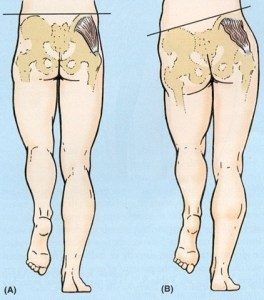What problems can stem from a switched off glutes? Let’s explore.
If you suffer from back pain, knee pain, tight hips or ankle restriction, then you might be suffering from ‘gluteal amnesia’.
Wouldn’t it be great if you could fix all of this dysfunction and become more powerful and athletic too? Well, the solution might be much easier than you realise…
The glutes might be the most important muscles in your body. They are the accelerator of a sprinter, the springboard for a long jumper and the horsepower behind an Olympic lifter. I challenge you to name any sport where the glutes are not integral to athletic performance. Seriously. If you can think of one, let us know. In fact, fully functioning glutes are fundamental in maintaining mobility as we age.
The problem is, most people spend all day sitting on their buns instead of activating them. This makes them weak and inhibited, and if a muscle is inhibited it means that neural signals sent from the brain will be down-regulated. In layman’s terms, the glutes stop doing what they are supposed to and the body has to find another muscle to do the work instead.
What do the Glutes Do?
- Extend the hips (standing up or thrusting the hips forward).
- Externally rotate the hips.
- Abduct the hips (allow you to lift your leg out sideways).
- Posteriorly tilt the pelvis (tip the pelvis backwards).
It’s fair to say that the hips depend heavily upon the glutes. So if the glutes aren’t working properly then our hips will be dysfunctional too.
Signs of Gluteal Amnesia
Tight Hips – If your glutes don’t work properly then the body has to find stability from somewhere else. The hip flexors are functionally opposite to the glutes (and are already likely to be tight due to prolonged sitting). In such a scenario, the hips will lock in order to provide the stability that is required. No amount of stretching will resolve this until the glutes are activated again.
Additionally, tight hip flexors can lead to Anterior Pelvic Tilt. This is where the pelvis tips forward (you can recognise someone with APT as they walk with their butt sticking out).
Lower Back Pain –Lower back problems are normally a symptom of dysfunction, as opposed to the cause. Your glutes are meant to stabilise the pelvis, but if they are inhibited your hips (which are no doubt already tight!) lockdown to provide this stability instead. This means you now have to find mobility from somewhere else – in this case, the loser is the lower back. Not only is the lower back now moving much more to compensate, but the tight hip flexors (psoas) which attach to the lumbar, are also pulling on your spine. Ouch!
Knee Pain –Sleeping glutes mean that there is reduced control of the femur. This means that the knee becomes more vulnerable and as such it is more likely to be pushed about.
Ankle Pain –If the hips are unstable, then the ankles can also lock down to restrict hip movement.
This list continues. If you find yourself nodding along to most of these signs, please don’t despair as you’re about to hop on the train to GluteVille.

How Do I Fix This, Coach Craig?!
The simple solution to fixing this is to learn how to squeeze the butt cheeks!! You can do this from a standing position or from a supine position (laying on your back). If you can’t feel any movement in your butt or your hips start to groan, then this is a clear case of gluteal amnesia.
If that’s the case then use this super simple drill to make a mind-muscle connection to the glutes, to re-write the neural pathways and develop your awareness.
- Lay on the floor.
- Place your hands underneath each bum cheek.
- Consciously squeeze your cheeks into your hands.
Any time that you are sitting down or standing about waiting for the kettle to boil, then take the opportunity to test your cheeks by squeezing them. It’s so subtle that no one will notice what you are doing. Once you have mastered the art of activating your glutes at will, THEN you can start to build strength. For many people, focussing on strengthening the glutes will be the turning point in enhancing both wellbeing and performance.
Building Strength
Glute legend Bret Contreras says the glutes should be hit from multiple angles. This makes sense, as the glutes have to perform multiple functions for the human body.
If you want to create an effective glute training template you have to ensure that you hit a glute exercise from each group below. Remember to apply the principles of good technique and progressive overload, just as you would with any exercise. Start with low loads, and exercises that utilise only body weight, then progress on to resistance bands, and then finally to weighted movements with barbells, kettlebells or dumbbells.
1) An abduction exercise – 2 sets of 10-20 reps – e.g. band standing abduction, band seated abduction, x-band walk, cable hip external rotation.
2) A quad-dominant hip extension exercise – 3 sets of 6-12 reps – e.g. back squat, front squat, walking lunge, reverse lunge, goblet squat.
3) A hip-dominant hip extension exercise – 3 sets of 6-12 reps – e.g. deadlift, good morning, single leg RDL, reverse hyperextension, kettlebell swings.
4) A bent-leg hip extension exercise – 3 sets of 10-20 reps – e.g. hip thrust, glute bridge, cable pull-through.
Add a hip stretch in-between each glute exercises and you will slowly start to notice that all your pains have become a distant memory. If that wasn’t enough, you will start to notice your jeans fit much better too!
I hope you found this article informative.
Be bulletproof.
Coach Craig.
Author - Craig Peterson - Personal Trainer & Mentor

Like what you read? Want to know more?
If you have a question about anything Health & Fitness that you want to see answered in a future article, or even fancy treating your brain & body to a whole day with one of our brilliant Mentors. Please contact us – we will endeavour to get back to you within 24hrs!
Remember – It is never too late to bulletproof your future self.
